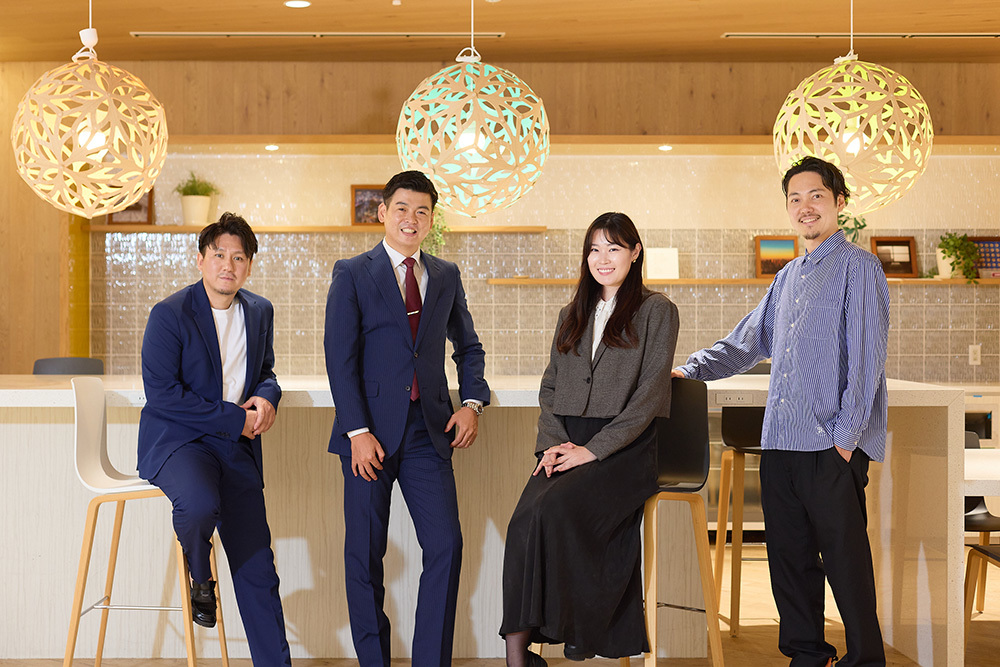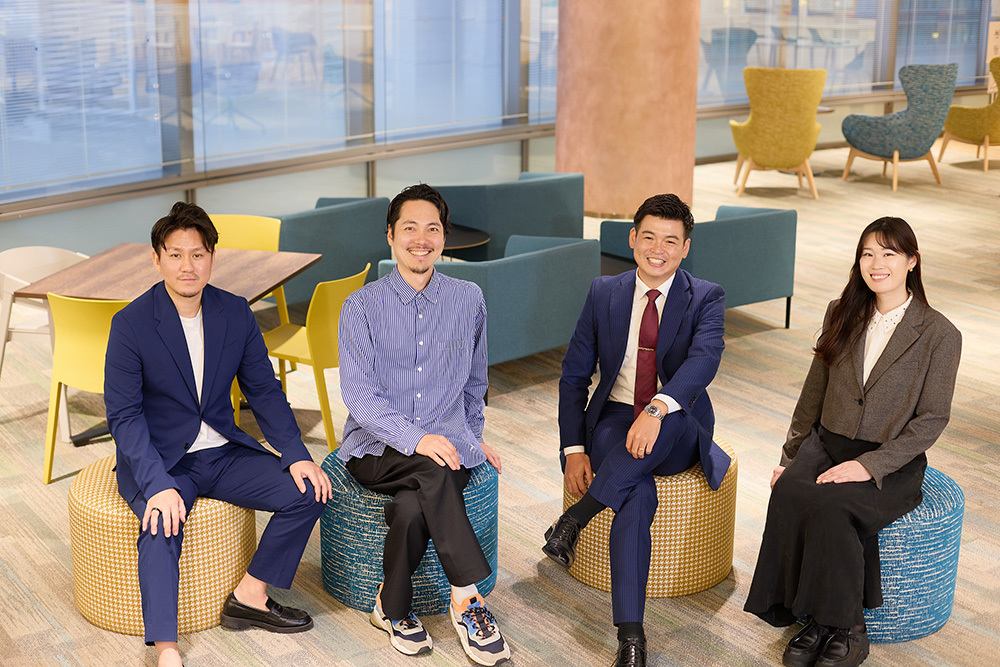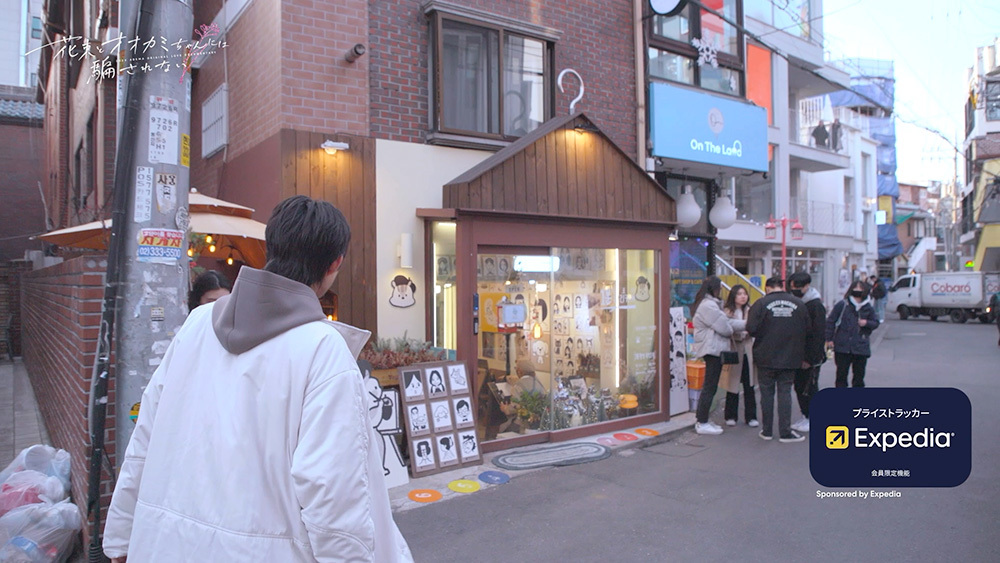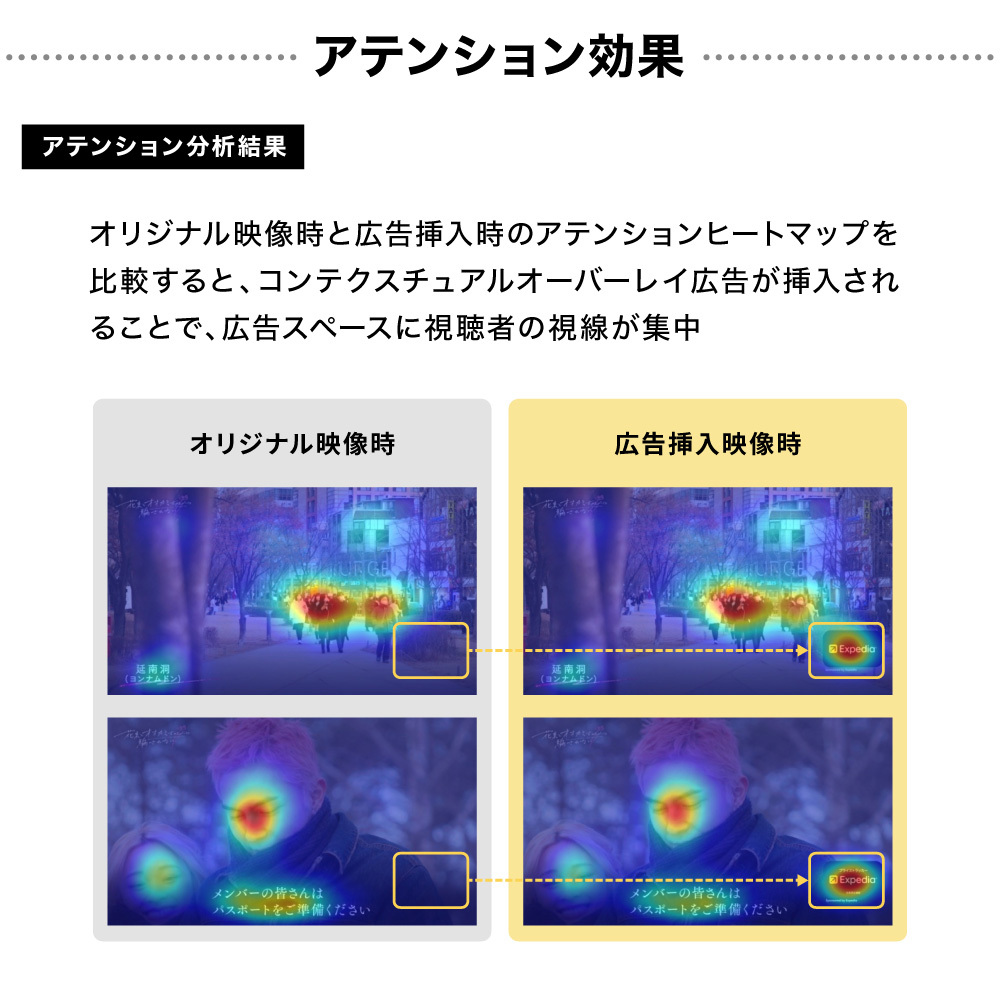
From left: Mr. Onodera, Dentsu Digital Global Center; Mr. Doi, GumGum Japan; Mr. Nakamura, Dentsu Digital Global Center; Mr. Ayase, ABEMA
In the digital world, various advertising solutions are developed daily. This time, we introduce Japan's first-ever "contextual overlay ad" in the OTT space.
This advertising technique analyzes program footage and displays ads within the video frame that match the "context" of the scene.
The Proof of Concept (PoC) was conducted by GumGum, a leader in contextual advertising, ABEMA, which operates a Connected TV (CTV) service, and Dentsu Digital Inc.
We spoke with representatives from each company about the background and results of the PoC for "Contextual Overlay Advertising," as well as their outlook for the future of the CTV market.
(Notes)
※1 OTT =
Over The Top. Services that deliver content to end users across multiple devices via the internet. This includes video streaming services and services like ABEMA that also support CTV.
The CTV Advertising Market Continues to Expand Year After Year: Key Trends to Watch Now

Dentsu Digital Global Center & Mr. Onodera
──First, please introduce yourselves and describe your roles in this project.
Onodera:I belong to Dentsu Digital Global Center. As a Group Manager, I collaborate with Dentsu Innovation Initiative to engage in R&D for domestic and international platforms, as well as building and promoting alliances and partnerships.
As part of this, we collaborated with GumGum to jointly plan a PoC for their new advertising delivery technology, "Contextual Overlay Ads," with an eye toward domestic OTT deployment. We involved ABEMA to conduct verification in an actual delivery environment.
Nakamura: I also belong to Dentsu Digital Global Center, primarily responsible for proposing and supporting the execution of advertising strategies for foreign clients. For this project, as the client manager for Expedia, I handled the delivery management and progress of this PoC.
Doi: I serve as Sales Director at GumGum Japan. For this PoC, I acted as the team hub, driving the project to ensure GumGum's "Contextual Overlay Ads" could be effectively integrated into ABEMA programming.
Ayase: I am a Product Manager for video advertising within the video streaming service "ABEMA" at AbemaTV Inc. Previously, I was primarily involved in planning and developing in-stream video advertising products, including developing new targeting methods and effectiveness measurement solutions utilizing our proprietary ad server.
This time, I worked with GumGum on a challenge to create a new advertising experience for ABEMA's original programs, handling everything from PoC design to delivery and effectiveness verification.
──Could you share insights on CTV market trends and developments?
Onodera: CTV has become deeply rooted in viewers' habits since the pandemic, offering the style of watching "whatever content you want, whenever you want" on a large TV screen.
As viewing behaviors diversify, CTV has become a complementary option for reaching demographics that are difficult to reach with traditional TV commercials. This includes younger audiences increasingly turning away from TV and casual viewers who no longer watch broadcasts in real time.
Within this landscape, ABEMA centers its approach around its own planned and curated program content. While in-stream advertising remains a core focus, we are also actively pursuing new advertising experiences tailored to the viewing experience. For example, formats like the "ABEMA Live Screen Ad," which displays ads seamlessly within the context of live broadcasts without interrupting the viewing experience, exemplify this approach.
In CTV, targeting and delivery optimization are advancing through the use of data such as viewing logs and user attributes. Furthermore, it has become possible to measure and visualize the attitude change effects, such as brand lift, associated with these deliveries. This enhances its value as an advertising medium that can either replace or complement TV commercials.
Ayase: With the proliferation of video streaming services, including ABEMA, I feel a viewing habit has taken root in people's daily lives: "watching favorite content anytime, anywhere." For instance, whether it's sports or dramas, it's becoming commonplace to watch on a large-screen CTV at home and then pick up where you left off on a smartphone while out and about.
Furthermore, when watching content on a "big screen" TV device at home, opportunities to use OTT/CTV services like ABEMA as an alternative to terrestrial broadcasts have increased. This is likely why the CTV advertising market is attracting so much attention. In fact, ABEMA has seen a significant increase in viewership via CTV since the pandemic.
Nakamura: Overseas, there are markets where CTV advertising has established itself as one of the primary advertising methods. We're hearing increasing requests from global clients with bases in those regions who want to implement similar initiatives in Japan.
──Why are companies focusing on CTV now?
Onodera: The underlying motivation is to capture changing viewing behaviors and the resulting media landscape realignment. Additionally, as mentioned earlier, CTV offers unique advantages: leveraging CTV-specific data for ad delivery and optimization, and conducting Brand Lift Surveys (BLS) linked to ad delivery. This allows for the visualization of attitude changes like ad recall, awareness, and purchase intent.
Nakamura: For me, one of CTV's major attractions is its ability to combine the strengths unique to television—like the "large screen" and "co-viewing"—with the advantages of digital, such as delivery optimization and effectiveness measurement.
In this PoC initiative with Expedia, we utilized a new ad format well-suited for CTV viewing, aiming to achieve incremental reach. Given the premium nature of "travel" as a product category, they sought significant ad placement for their messaging. We found CTV services , often viewed on TV devices or projectors, to be an excellent fit.
Japan's First! What is the Technology and Market Value of "Contextual Overlay Ads"?

Mr. Doi, GumGum Japan
──What exactly is GumGum's "Contextual Overlay Ad"?
Doi: It involves displaying the most relevant ad within the frame of the corresponding video at the optimal moment, based on the context of the TV program, specifically targeting scenes or locations within the show.
The "contextual advertising (context-targeting ads)" we've introduced in previous installments analyzes context based on text within media like news sites. Beyond that, GumGum comprehensively analyzes all elements within content—text, images, audio, and video—using proprietary technology, enabling a more accurate understanding of "context."
For example, even within automotive news, which can encompass various contexts like "car accidents" or "new car sales," GumGum can discern the appropriate context. It can then deliver automotive ads to readers engaged with positive articles about "new car sales."
Since users are highly likely to be viewing the product with genuine interest at that exact moment, this approach is gaining attention as a highly effective advertising method.
This new "Contextual Overlay Ad" can be seen as the video program version of that concept. Already launched in the US and Canada, it's gaining attention as a "high-quality ad experience" that doesn't disrupt content viewing.
──Could you share the development background?
Doi: With typical "in-stream ads" displayed on CTV or video sites, there are inevitably cases where the screen switches and an ad plays, for example, right when the content reaches a climax. Many viewers find this abruptness jarring. So, we considered when it would be natural to deliver ads to viewers, leading us to develop a format that doesn't interrupt viewing.
──What technology does the "Contextual Overlay Ad" use to analyze the program content?
Doi: For content on the open web, we comprehensively analyze various elements like text, images, audio, and video information. Regarding images, we possess technology that can meticulously analyze what objects (people, items, company logos, etc.) are contained within each individual image, rather than just reading the Alt text set for the image. Since video is essentially a series of still images like a flipbook, our technology—which analyzes each image at the object level—is highly effective.
Furthermore, beyond just the text information provided by video audio descriptions, we can gain a deeper understanding of the video's content and context by analyzing the objects within the footage itself. This enables us to understand the video's context with high accuracy.
──So, you already have technology that analyzes text, images, video, and audio to read the context of content, and you combine these to perform "video analysis" and "deliver appropriate ads," right?
Doi: Exactly. However, we still have areas where our Japanese analysis lacks sufficient data, so we aim to refine this further. Japanese video content, especially variety shows and comedy, often features unique expressions that require understanding beyond literal meaning—reading between the lines or sensing the atmosphere. Accurately understanding and analyzing such scenes demands advanced contextual comprehension, which we see as a key technical challenge moving forward.
──You mentioned "not disrupting the experience." Does that mean ads are positioned so they don't overlap with subtitles or people's faces?
Doi: Ads are primarily placed in one of the "four corners" of the video. Content providers can adjust the ad placement to avoid overlapping with performers or other elements. Additionally, our results show no significant difference in attention based on ad placement. This allows ads to be displayed in a way that aligns with the user experience while maintaining performance.
──What led ABEMA to collaborate with GumGum on this PoC, and why did Expedia participate?
Ayase: At ABEMA, we aim to provide advertisers with new advertising value and offer users continuous "free viewing" opportunities for premium content by developing a "high-quality advertising experience" that adapts to diversifying viewing environments. As part of this effort, we actively explore various ad formats to achieve this "high-quality ad experience." This led us to design a PoC for a new advertising technique, "contextual overlay ads," together with GumGum and Dentsu Digital Inc.
For the PoC, we selected the popular original dating reality show "Bouquet and Wolf-chan Won't Be Fooled" from several candidate programs. The reason was that the show is filmed in Korea, features many overseas dating scenes, and we felt the travel service Expedia was a perfect fit for those scenes.
Nakamura: As mentioned earlier, the background to proposing this PoC to Expedia was that advertisers were also strongly aware of the risk that traditional video ads, displayed out of context, could create a negative impression for users.
Especially in branding, the context where ads appear and the quality of user touchpoints directly impact effectiveness. Therefore, formats like "contextual overlay ads," which blend naturally into content without disrupting the viewing experience, were considered a strong potential solution.
Effectiveness confirmed through metrics like "service recall" and "attention"!

ABEMA, Mr. Ayase
──Please tell us about the PoC overview and results.
Ayase: The PoC period covered the catch-up streaming (November 18 - December 1, 2024) and the marathon broadcast (November 18 - December 1, 2024) of "Don't Get Fooled by Bouquets and Little Wolves." This was strictly a PoC to investigate advertising effectiveness, so ads were manually placed within specific episodes.
Nakamura: We verified advertising effectiveness using two metrics—BLS and attention measurement—targeted at program viewers. In BLS, Expedia significantly outperformed competitors not only in "ad recognition" lift but also in "recall" for the keyword "travel." A significant lift was also confirmed in "interest."
──Why did "recall" and "interest" increase more than "advertising awareness"?
Nakamura: We believe this occurred because the format allows viewers to encounter the ad "simultaneously" with the program without disrupting its flow. As a result, the Expedia brand was naturally remembered as part of the viewing experience, ultimately leading to higher recall.
Ayase: Indeed, since the in-program ad format allows for promoting highly relevant products within the context of the show being watched, viewers likely accepted it very naturally—as part of the program and as valuable information. Furthermore, combined with it being an unfamiliar ad format, viewers may not have consciously perceived it as "advertising" to that extent. In that sense, I believe it offers a highly receptive advertising experience.
──What about the other "attention measurement"?
Ayase: Precisely because it's integrated so naturally into the video, we wondered: Could it actually be harder for viewers to focus their attention (attention) on the ad? To thoroughly verify this concern, we utilized NTT Data's creative evaluation solution "D-Planner," which combines neuroscience and AI. Based on learning from vast amounts of historical data, it predicts "where viewers are focusing their attention in this scene" and displays it as a heatmap.
Analysis of all scenes in this PoC clearly visualized that viewer attention was concentrated on the Expedia ad portion within the video.
The key takeaway from this attention measurement was successfully visualizing "how much viewers focused on the ad" using a highly accurate AI model. Amidst viewers' attention being drawn to various areas of the content, the fact that their eyes properly landed on the Expedia ad demonstrates that this ad format worked.
──How did Expedia respond to these results?
Nakamura: The client representative gave positive feedback about working on this new advertising format. However, we believe there is still room for improvement regarding the optimal creative approach for this format. We look forward to continuing to explore the best creative formats suited for "Contextual Overlay Ads" together.
Expedia Comment
Our goal was to verify how well "Contextual Overlay Ads" could capture user attention without disrupting the viewing experience. The results showed the ad display area achieved approximately 4.8 times the attention-grabbing effect compared to non-ad areas, confirming that the format itself blends naturally into the content while maintaining high visibility.
However, the lift in ad recognition was limited, likely because the ads integrated too seamlessly with the content. Particularly impressive was the effect when ads appeared during travel-related scenes, where brand recall increased by +151% and interest by +127%—clear results on metrics critical to our company.
Moving forward, we expect this format's potential to expand further through deployment in more high-engagement programs and the evolution of attention-based measurement methodologies.
── German Arango (Expedia Group Senior Media Specialist)
── How has the internal reaction been at ABEMA?
Ayase: Through this PoC, we confirmed strong advertising effectiveness not only in terms of high ad receptivity but also in recall and interest generation. This demonstrated the potential as a new advertising experience, generating mostly positive feedback internally.
On the other hand, regarding the nature of advertising expressed within the video content, it's crucial to deepen internal discussions about which scenes are more acceptable to viewers and conversely, which scenes should be avoided. We aim to establish the advertising format as a "high-quality advertising experience" that does not disrupt the program viewing experience.
We want to establish "contextual overlay ads" across platforms.

Dentsu Digital Global Center, Mr. Nakamura
──I believe the PoC achieved certain results. Based on these outcomes, what are the current challenges?
Onodera: First, we need to accumulate more case studies and expand successful patterns. Beyond that, we see our role as establishing an environment where we can more precisely evaluate effects like shifts in user attitudes and motivation. This will help CTV advertising become a standard choice for clients.
Nakamura: While digital advertising continues to expand, it often compromises the user experience. That's precisely why designing touchpoints that satisfy both users and advertisers is crucial for delivering the true value of advertising. We believe our role as an agency is to consciously balance this from the menu selection and planning stages to create better advertising experiences.
Ayase: At ABEMA, we will continue our challenge with "Contextual Overlay Ads." Precisely because we have direct touchpoints with viewers, we want to pursue how this ad format can deliver valuable advertising experiences for both advertisers and viewers—understanding which viewing scenarios and presentation methods make this possible.
Simultaneously, I believe attention will grow for this ad format as not only ABEMA but various professional content media take on this challenge, increasing the number of cases proving its advertising value.
Doi: I also believe we need to put more effort into the creative aspect. GumGum's significant strength lies in its ability to deliver rich advertising creative expressions.
Moving forward, GumGum plans to leverage video context data and creative data to provide clients with insights like, "This type of creative resonates well in this context," and "Placing ads at this specific moment can drive user attitude shifts and capture high attention."
By proposing the right context and creative, we aim to deliver ads that resonate with many users.
──What are your long-term outlooks?
Ayase: ABEMA has several business models, but what we value most is consistently providing advertisers with new advertising value through optimal ad experiences and continuing to offer users high-quality "free viewing" opportunities.
For traditional in-stream video ads, we will continue to prioritize the "advertising quality" ABEMA has always focused on: the timing of commercial breaks, strict ad screening, and safe ad placements. Simultaneously, we will actively pursue new advertising experiences like the one introduced this time.
To achieve this, we also want to deepen our collaboration with partners like GumGum and Dentsu Digital Inc. who share ABEMA's vision and are willing to take on new challenges together.
Doi: At GumGum, we want to deliver more relevant ads aligned with user moments across various web and video content. To achieve this, we plan to build the necessary environment by collaborating with agencies like Dentsu Digital Inc., platform providers like ABEMA, and various vendors.
Nakamura: From our perspective, we increasingly hear global clients ask, "Can't we implement such initiatives in Japan?" We feel formats prioritizing user experience will be increasingly demanded going forward. We hope to broaden the scope of domestic applications while accumulating industry-wide insights.
Onodera: Within Japan's CTV landscape, ABEMA is a platform wielding significant influence. In this initiative, GumGum's expertise in contextual advertising and attention measurement was integrated into ABEMA's pioneering efforts. This implementation represents a step forward in creating advertising experiences unique to CTV. We look forward to continuing such collaborations to deliver valuable initiatives together.

























